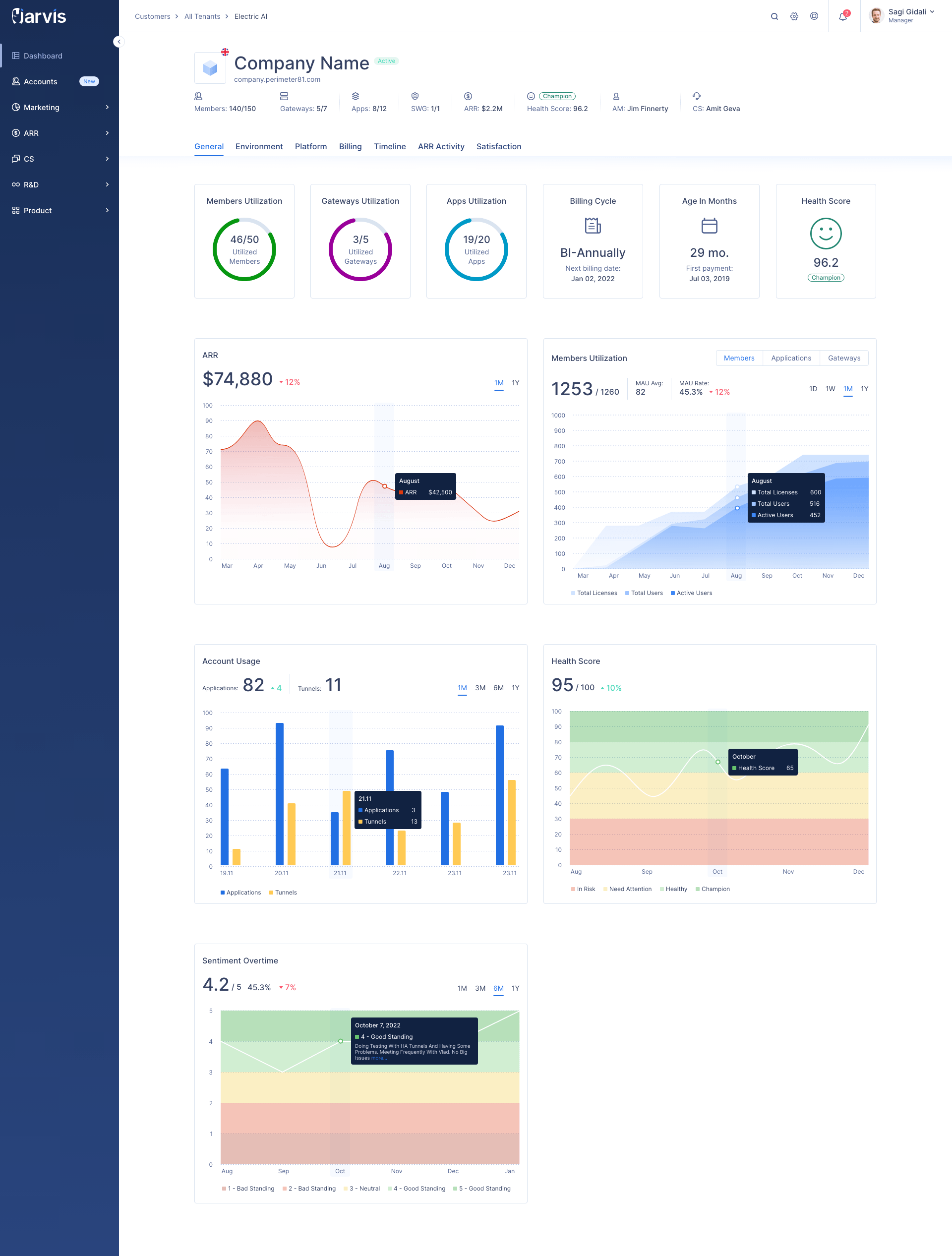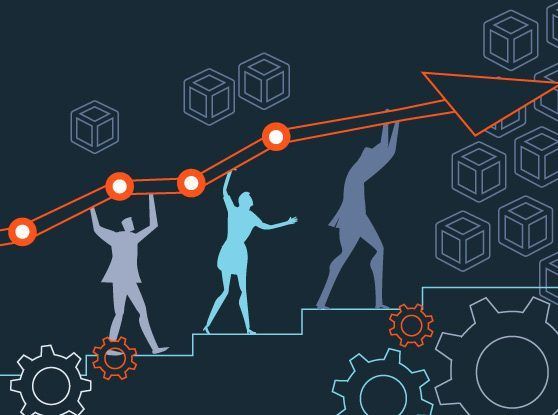
The world’s most sophisticated fighter jet, the F-35, costs ~$130M, flies at Mach 1.6 (~1.2K MPH), and contains some of the most sophisticated technology and instrumentation on the planet. Harnessing the power, speed, and precision of the F-35 requires focus and split decisions to be made in seconds. Pilots rely on rigorous training and a sophisticated cockpit dashboard that provides them with all the necessary information and metrics to be successful.
Similarly, as companies scale and look to maneuver the competitive landscape to gain an edge, having company performance data at their fingertips will help them accelerate and maintain their growth.
What does it mean to be a data-driven company?
As companies accumulate a larger set of customers, it’s likely that the ability to interact with each customer individually becomes more complicated. With that comes the lack of knowledge on how the account is performing. Is the customer likely to churn? Is there an opportunity for expansion? Are users engaging with the product regularly? Is there a new release that needs to be pushed to the customer? What issues might the customer be having with our product? All the answers to these questions likely live in disparate systems for most ScaleUps today, which leads to a fragmented and/or incomplete profile of the customer.
Some companies, however, are increasingly trying to break down barriers between their data systems. In doing so, they can create a holistic picture of the customer. When data stitches together into one fabric, companies can slice and dice customer data in infinite ways to understand their customer and proactively serve them.
A data-driven company is one that seeks to capture foundational data across the organization and marry it together to unlock new insights that will accelerate and maintain business growth.
What are the best practices of a data-driven company?
A data-driven company exhibits the following:
- Removes barriers between data sources to unlock additional customer insights
- Spends a significant, but proportional, amount of time and resources on connecting all customer-related data
- Is thoughtful in the purchase or creation of visualization and activation tools to manage customer data. The number of tools used to capture data does not necessarily need to be siphoned if the dollars to invest exist. If the data feeds into one place, it is simply an opportunity for more datapoints.
- Creates dashboards and ways of viewing insights all the way down from the customer level up to the health of the overall business
- Embeds the use of data and tools as a part of company culture and involves the company in the creation of such tools
- Continuously iterates on data usage
A tangible example: Interview with Perimeter 81 co-founders
In April 2022, we sat down with Insight portfolio company Perimeter 81’s co-founders Amit Bareket and Sagi Gidali to better understand how they built and continue to build their data-driven company. Their story is somewhat unique in that they have chosen the path of building their own solution vs. relying on various third-party solutions to meet their needs. This may not be the path that everyone chooses, but it is the path that has worked for them and their company.
From the conception of the idea to build a single data pipeline for all customer data all the way to the creation of their proprietary visualization tool called Jarvis, Amit and Sagi provided us a glimpse into how their data-driven company operates on a daily basis.

How did Perimeter 81 get started? Tell us the story of building the company to where it is today.
- Amit Bareket: Sagi and I had a consumer VPN company called SaferVPN, which sold VPN security to consumers, online marketing, and self-service. VPN back then for consumers was kind of a commodity, but we had tens of thousands of customers and some of those customers had businesses. We had a great product, and our differentiation was that we had automatic WiFi security. It allowed us to activate the VPN automatically every time the users went on a public or unsecured WiFi. Our product made even more sense when businesses wanted to be secure with remote team members. As we went to conferences like CyberTech in 2017, we saw an immense demand from businesses coming in. We reached out to different larger organizations to ask them about how they envisioned corporate networks developing in the next few years, and they all said that they saw the internet becoming the corporate network. We were hearing that in the next few years, 75% of the workforce would work at least one or two days a week from home. When COVID happened, it accelerated that transition.
- Sagi Gidali: Another trend we saw was with digital nomads, people who traveled all around the world and worked remotely. Back in 2017, we saw that offices were going to be getting emptier. We decided that there was a huge opportunity, and Amit convinced me that we needed to shift from the B2C to B2B. That’s when we started Perimeter 81. We still sell the B2C brand, and we kept the IP and infrastructure. It’s allowed us to get to market really quickly.
- Amit Bareket: As we built this new B2B business, we were able to fix all the obstacles we faced the first time around on the consumer side. One of those key areas was how we were using data. We had historically utilized out-of-the-box solutions to manage our data. This time, though, we tried maybe 10 different platforms like Tableau and many others, but we didn’t get the visibility that we wanted. We couldn’t understand what was going on with our customers or get the insights we needed to accelerate business growth. Sagi was relentless that none of the solutions were working well enough for what we needed and convinced me that we should invest and build our own thing. We saw what the team at Monday.com had built with BigBrain and fell in love with their tool and its capabilities, so we decided to make the right version for Perimeter 81. At first, I was hesitant because I didn’t feel like we had the resourcing we needed, but once we pivoted to our B2B solution and were able to raise venture capital, we were able to invest significantly in building our own custom-tailored solution, which we call Jarvis. It’s a tool that shows the data exactly how we’d like it to be shown. Every company has a unique way of operating, so we wanted to build something that fit our operations.
- Sagi Gidali: The name Jarvis came about because I’m a huge Marvel fan. Jarvis is Tony Stark’s personal assistant. So that’s where the reference comes from!

What was the process of building out your tool Jarvis and the surrounding data pipeline?
- Amit Bareket: The first thing you need to do is align all your data sources into one single source database. Ours sits in Amazon Redshift. Previously, we had many different data services. You have GitHub, Salesforce, Intercom, FreshDesk…any company probably has 40 different SaaS solutions and each one has a different set of data information. It’s only pieces alongside a user story. We didn’t have one place where you could sit like in an F-35 plane and see all the information in a very customized way. So, we unified the data into one pipeline. Detailed data down to user clicks is logged in Redshift for us. From there, we can ask any query that we want.
- Sagi Gidali: It’s all about making the right decisions and avoiding making mistakes. By having all the data in front of you, you can do just that. You can take every tactical and strategic decision and support it with relevant data. That’s the biggest strength of what we did. So, once we have all the data sources pulling into one place, we have a few destinations where the data can be visualized. Jarvis allows us to drill into each customer’s data and calculate different models on each customer. Looker allows us to slice and dice and create ad hoc reports and statistics. Then the data also feeds into places like Salesforce, Slack, and others. Everything is taken from the same source. That is the power of what we created.

How did you go about resourcing this initiative?
- Sagi Gidali: We started small. When we first started the company, we allocated two developers and one designer. From there, we started to develop Jarvis. We really started to allocate resources to this when we heard things like one account manager coming to us and saying, “It takes me four hours to collect all the information I need from emails, Salesforce, Zendesk, and all the other tools where I need to run SQL queries.” So, our mandate was to create a tool that gives a holistic picture of the customer to understand what’s going on inside. For example, what is the ARR of the customer? Which features is the customer utilizing? What is the trajectory of the customer? We also eventually added a BI team who are stakeholders within this project. They work with other teams within the company to build what is needed. Today, we have two frontend developers, two backend developers, and one product manager dedicated to Jarvis. We also have 10 or more engineers who are working on the data at any given time.
- Amit Bareket: At the end of the day, you just need two strong developers to start. It’s a hard decision because you have to take them out of developing the product, but two engineers can build everything. We trained them on KPIs and SaaS metrics and gave them a general architecture of what we were looking for and then they were able to build from there. Then over time you can extend to scaling a team around it as needed. We’ve also gotten the question before on what the limit of investment is. That’s not a good question – Sagi and the team always want more, and our job is to balance that objective with the company’s overall trajectory.
How has what you’ve built helped different stakeholders such as internal and end customers?
- Sagi Gidali: Transparency is one of the core values of our company. We wanted to make it so everybody can come and see customers and any metric in here. Customer Success and Account Managers are the heaviest users – they come into these tools every day when they are assisting customers. They need all the information they can get, and they need to pull it very, very fast. One of the key differentiators of Perimeter 81 is our customer service and support. To deliver a service at this level, we need to give our teams all the information in real-time to assist proactively. Even before something happens, we will know. Or if something does happen, we will know how to act or assist. The idea is that with increased visibility comes increased efficiency, so people can do more in less time and processes can be automated.
- Amit Bareket: One important thing to point out is that this is an evolution – taking all the data, getting it into a data model (Redshift), and creating datasets and operations to connect the views. Then we were able to start building out visualization tools. We started with Redash, which is opensource, when we didn’t have much to invest, but then we upped a few levels over time to Jarvis, our own tool, and also added Looker to slice and dice. Our tools have become more sophisticated over time to serve the use cases that we have.
- Sagi Gidali: Now we’re even moving into adding alert mechanisms and integrations so Account Managers will get alerts on their accounts based on specific events. Another example is that CS can roll out versions to customers through our tools or schedule maintenance. You can start to do actions with the accounts through what we’ve built. In Support, we’ve created new tools where you can do a live session with a customer and log in to the customer’s account through Jarvis. This is a product within a company that allows us to work better, faster, and deliver impact more efficiently.
If we took your data tool Jarvis away, what would the impact to the business be?
- Sagi Gidali: It would be like not delivering on expected results. When Jarvis once shut down for an hour, we received 50 Slack messages of people saying “What happened to Jarvis? I can’t see my accounts.” The information could still be accessed through other means, but it would take a lot of time and our team would not see the relevant insights. That means we can’t create and maintain a healthy relationship with our customers. It affects productivity.
When there are other customer data aggregation tools out there, how did you decide to build instead of buying?
- Amit Bareket: I don’t think it’s this or that. It’s this and that. You can still use these other tools, but eventually, we felt we needed a single source of truth to collect all the information and stitch it together. For example, we have a lot of information that we are now feeding back into Salesforce. Imagine you are flying an F-35 and none of the systems are talking to each other, and you don’t have all the available information. This allows us to move quicker and keep everything focused.
- Sagi Gidali: I also think this tool has a lot to do with our culture. When you have such a tool ad it belongs to the company, it creates engagement, stickiness, pride, and retention. People like to contribute to Jarvis. You can’t measure the ROI of culture, but there is a halo effect of implementing such a tool.
- Amit Bareket: I think the other thing to remember is that you need to be careful to not always rely on the data and tools. You need to also trust your intuition and invest in the business and take some risks. At the end of the day, Jarvis and these other tools are showing us the past, not the future. We have prediction models built into Jarvis, but it’s based on past data. For example, if you believe that the MSP business will grow rapidly, your data may not tell you that that is going to happen, because you have no past data to support it. We are a data-led company, but we are careful to trust our intuition. You can take all the data points, and some may support your decision, but we are humans in the end.
What was the hardest part of building all of this?
- Amit Bareket: Throughout the process of building, we tried to utilize many, many different out-of-the-box solutions, because we felt why should we be building networks? That was the biggest hurdle. To get to a point where we had a single database that collects information from all the different data sources. You try to avoid it, because you need three months of investment to build the data pipeline, but instead we were spending two years to find a solution that didn’t work, instead of investing three to five months building it once. Making that decision was difficult.
- Sagi Gidali: Going from vision to execution, you need to bring the team along. You need to prioritize – it’s like building a new product. You need to invest time in research. You need to figure out how you are going to get people to start using it – you need to win the love of the crowd. We had a few iterations at the beginning that didn’t work well from an architecture standpoint. We needed to hire different people too until everything clicked and we got the right solution. Once we had a solid baseline, we added more features, screens, and value. I was very engaged – in the beginning, I worked on every screen myself, including creating the entire UX and UI with our designers. Today we have a Product Manager who is taking requests from all the different stakeholders and building a roadmap. The other hard thing is making the tradeoff between using resources to develop Perimeter 81’s core product versus this internal tool. It’s a question of where we draw that line. Also in that same vein is the question of what are the uses of each of the internal tools that we have – what is Looker for vs. Jarvis? How do we consolidate and maintain a small number of tools all with different uses?
How did you drive adoption?
- Sagi Gidali: We created a product that delivers a lot of value to the stakeholders. We pushed Jarvis – it starts from the onboarding of a new employee where they get a session on Jarvis. We have sessions when we have new feature releases with the entire company. We send newsletters and collect requests. We involve the company in building Jarvis. When you build the product together, you create stickiness and engagement. They need to see the information at the end of the day. They need to see the expansion potential or churn risk. It gives everyone access to the low-hanging fruit. And as we add more tools – for example, we just added Gong – we can connect the demo call, the transcript, the QBR, all the different touch points, CSAT, tickets – and when you connect everything and visualize it in Jarvis, you get the full picture. You get to the truth of the account. Then there is also the predictability piece, which gets stronger as we layer in tools. We have a score that is calculated for the account based on all the different sentiment inputs, financial, and usage data that we have.
What is one thing you wish you’d known before going on this journey?
- Amit Bareket: The journey was necessary for us to learn. You learn from your mistakes to become better. We were a bootstrapped company back then – it only allowed us to invest in the right time and place in resources. We needed to develop and change over time and make the mistakes we did with Jarvis to get to where we are today. I wouldn’t replace the experience in any way. The other thing is that we did invest a lot in trying different out-of-the-box platforms that didn’t end up working for us. Don’t be afraid to put that behind you. We did the same thing with SaferVPN when we moved to the B2B route.
- Sagi Gidali: I would say just believe in what you do and don’t listen to others. Many people said to us, “Why are you doing that? You are investing so many people and such a huge amount of money and effort in Jarvis.” People don’t always understand the vision or idea. The result was amazing – it’s a tool that people are using daily.
Where did you get the name Perimeter 81 from?
- Sagi Gidali: 81 is the elite intelligence cybersecurity unit in the Israel Defense Force. That’s where Amit came from. I came from the 9900 unit, which would’ve been a much longer name. The perimeter we’re talking about is the perimeter around all the resources that live in the cloud, on-prem, and public internet. We also wanted it to be an ice breaker when meeting new people like it is right now!
- Amit Bareket: It’s a good name because first off, it’s catchy. The internet is the new corporate network, so we are the new perimeter around the office space.












